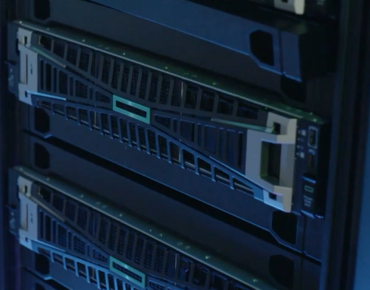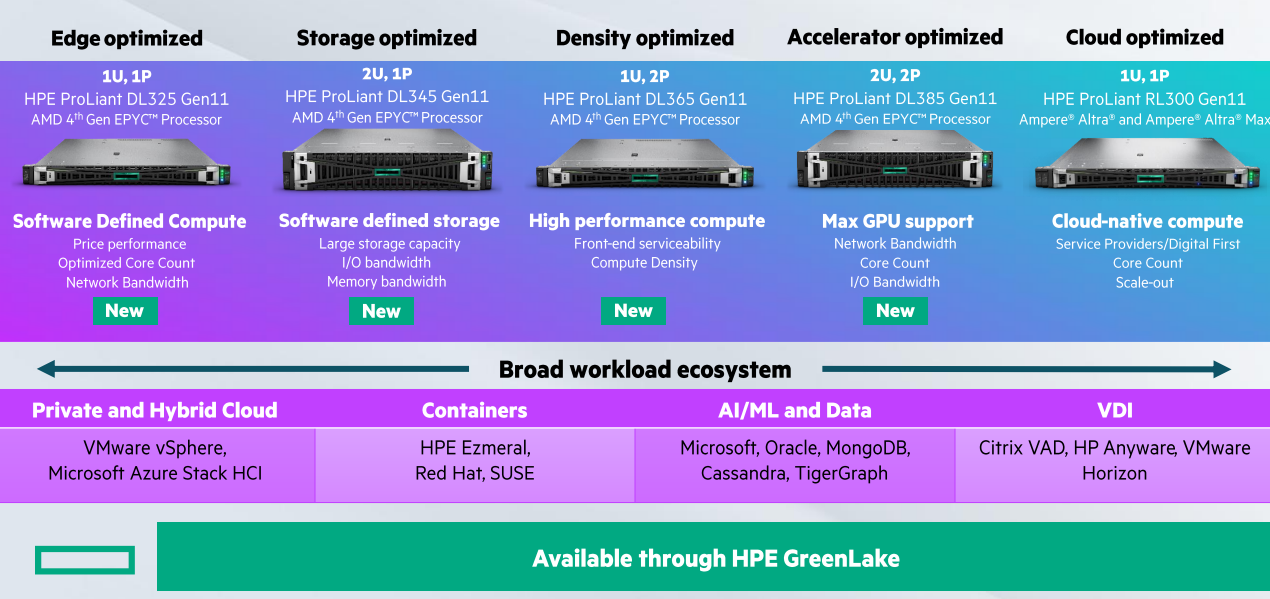HPE Adapting New Server Hardware to Changing Cloud Models

Server hardware has taken a backseat to software-defined virtual machines handling datacenter workloads, but HPE is emphasizing the importance of hardware in these virtual operating models.
HPE created waves when it released the next-generation ProLiant Gen11 servers with a flagship server based on Arm CPUs, which sent a strong signal that it was diversifying outside of its historical reliance on x86 chips from Intel and AMD.
The RL300 ProLiant Gen11 Arm server was targeted at cloud-native applications, which benefit from a large number of cores and low-power scalability for Linux applications like Apache and NGINX in containerized environments.
On Tuesday, the company brought x86 processors back into the ProLiant Gen11 portfolio, with new servers targeted at high-performance computing, storage, machine-learning and virtualized environments. The servers, which will ship next week, will be based on AMD’s 4th Gen Epyc processors, which are also called Genoa.
The new x86 servers are for workloads that need higher-performance chips for the execution of more instructions per cycle, and facilitate the multiple accelerators such as GPUs and FPGAs for high-performance computing.
Before the onset of cloud computing, x86 servers were able to handle applications like databases, ERP and analytics tools deployed on premise. Arm made its mark as developers shifted the use of common tools like the LAMP (Linux/Apache/MySQL/Python and Perl) stack for web-based software to the cloud. Intel and AMD adapted their x86 chips for cloud implementations of high-performance scientific applications and artificial intelligence computing, which rely on accelerators.
The new x86 ProLiant servers will ship on the same day that AMD officially announces its 4th Gen Epyc chips on Nov. 10. The servers have faster throughput technologies with support for DDR5 memory and PCIe Gen5 interconnects. The servers also support CXL (Compute Express Link) version 1.1, a technology that facilitates superfast communication between GPUs, memory, CPUs and other components.
The new offerings include the ProLiant DL385 Gen11 server, a 2U, two-socket box that supports up to 96 CPU cores, 6TB of DDR5 memory, and up to 48 SSDs. The box is designed for machine-learning, which typically requires configurations supporting accelerators like GPUs. The system has eight PCIe 5.0 slots for GPUs.
The other ProLiants are variants that support up to 96 x86 cores, and include PCIe 5.0, CXL 1.1 and DDR5 memory support. The machines include DL365 Gen11, which is a 1U, two-socket server, which supports up to 96 CPU cores, 6TB of DDR5 memory and 2 x16 PCIe 5.0 slots.
The DL345 Gen 11, which is a 2U, single socket server (pictured, right), and the DL325 Gen11, which is 1U single socket server, support up to 3TB of DDR5 memory. The DL345 has 6 x86 PCIe 5.0 slots, and the DL325 has two such slots.
 The servers are designed for HPE’s hybrid cloud environments called GreenLake, which the company is marketing as a utility-style service where customers can pay-as-they-go for compute requirements. HPE has built a software environment within the model that supports applications such as VMware’s vSphere, which dominates the virtualization markets, and Red Hat and SUSE’s Linux implementations.
The servers are designed for HPE’s hybrid cloud environments called GreenLake, which the company is marketing as a utility-style service where customers can pay-as-they-go for compute requirements. HPE has built a software environment within the model that supports applications such as VMware’s vSphere, which dominates the virtualization markets, and Red Hat and SUSE’s Linux implementations.
The new systems support the Apache Cassandra application to manage databases, which has been benchmarked to deliver better performance-per-watt and cost savings on Arm processors. The benchmarks are from Ampere, which provides the Arm silicon for HPE’s ProLiant RL300 Gen11 server.
Companies can combine their public cloud and on-premise infrastructure into a single compute system with GreenLake. In some cases, HPE decides on the best hardware and software combination for customers. In cases like those, the hardware is virtualized, and invisible to customers.
But there are customers who specify the hardware and processor needs, said Krista Satterthwaite, senior vice president and general manager of mainstream compute at HPE.
“We’ve got customers that are chasing performance. They want the absolute best performance they can get because their workloads demand that. Those customers are going to run to the latest and greatest infrastructure,” Satterthwaite said.
For example, one customer is beefing up their video surveillance with in-store servers, and they are buying more headroom than they need when it comes to the ability to support accelerators such as GPUs.
“They’re like, ‘hey, forget what we need right now. We’re building this for the future.’ When you have these generational changes, and they don’t come around every year, a lot of close customers are taking the opportunity to build for the future,” Satterthwaite said.
Buying patterns for HPE ProLiant’s servers changed in recent years, with a focus on specialization depending on the workloads, which is where the Arm-based server offering fit in.
“Whereas before they would buy a DL380 and run everything on it. We are seeing much different behaviors,” Satterthwaite said.
The x86 servers will serve the rest of the general-purpose computing offerings in GreenLake, she said.
“We see the enterprise to be primarily what we have in our offerings for the rest of the ProLiant family,” Satterthwaite said.











